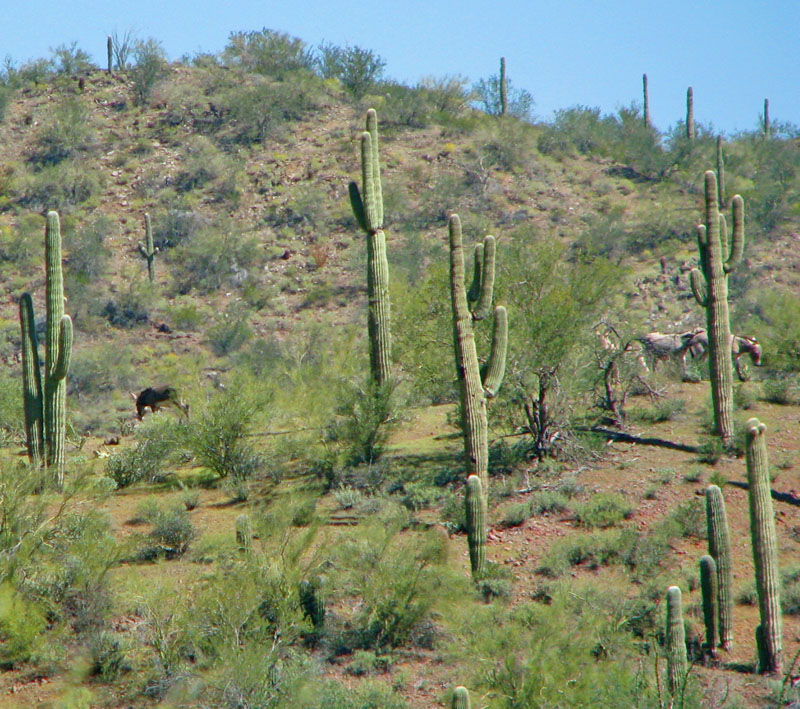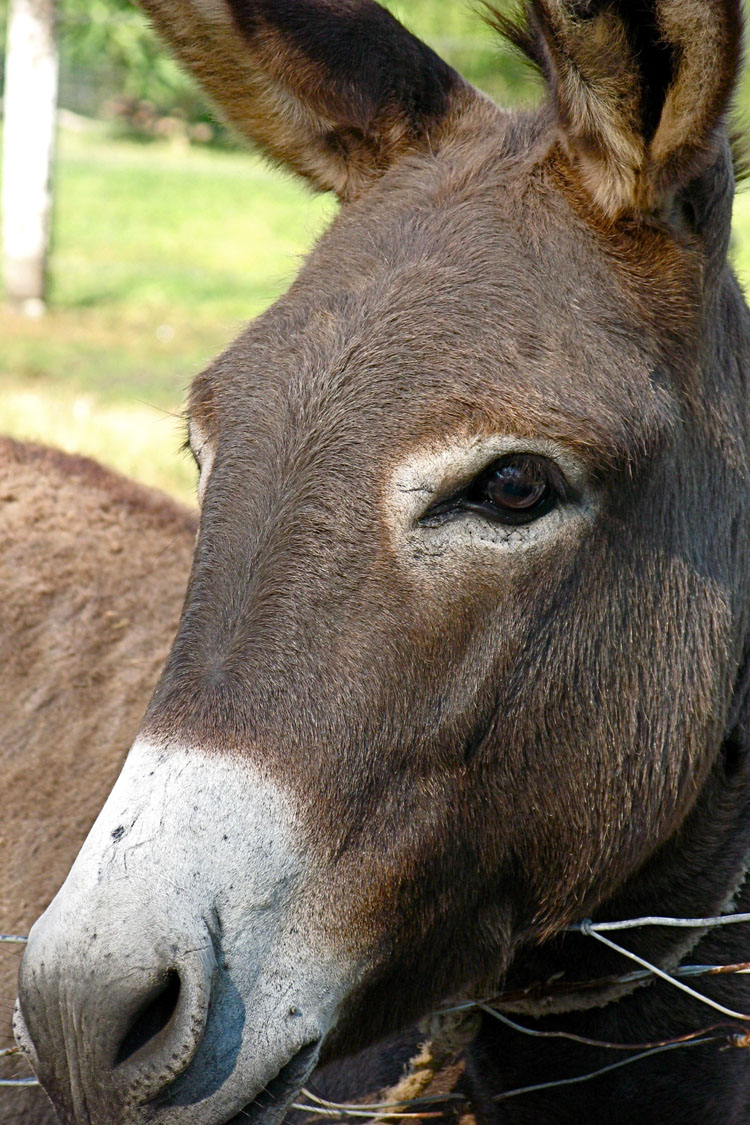Feral Quadrupeds of Interest
In an earlier post, there was an oblique mention of seeing “Feral Quadrupeds of Interest”. These would be the wild burros who live in the desert around Lake Pleasant, Arizona.
 On our hike the other day, E and I encountered a small group of them. They are often described as “more likely to be heard than seen” and in fact, we did hear them first. A loud braying filled the quiet air of the desert morning, drowning out the breeze in the saguaro spines, the jingling of the Black-throated sparrows, and the chup-chup-chup of the male cardinal. It was instantly recognizable — after we remembered there were supposed to be feral donkeys out here! — and after looking around for a bit, E spotted a group of about 5 on the top of a ridge. They were not very close, but we did get some distant images of them, one of which is above. The adults are gray, and you can see them on the very right-hand edge of the photo, behind a saguaro and a palo verde tree. There’s a younger, darker animal visible grazing near the left side of the picture. (Photo by E. Shock.)
On our hike the other day, E and I encountered a small group of them. They are often described as “more likely to be heard than seen” and in fact, we did hear them first. A loud braying filled the quiet air of the desert morning, drowning out the breeze in the saguaro spines, the jingling of the Black-throated sparrows, and the chup-chup-chup of the male cardinal. It was instantly recognizable — after we remembered there were supposed to be feral donkeys out here! — and after looking around for a bit, E spotted a group of about 5 on the top of a ridge. They were not very close, but we did get some distant images of them, one of which is above. The adults are gray, and you can see them on the very right-hand edge of the photo, behind a saguaro and a palo verde tree. There’s a younger, darker animal visible grazing near the left side of the picture. (Photo by E. Shock.)
 These are the naturalized descendants of work-burros brought into the region by miners and others during the 1880s when gold prospecting and other pursuits were a big deal in the area. (I’ve read that Phoenix, on the Salt River, actually started as an ancillary vegetable-growing supply community for the then larger population around Wickenburg, where the local river, the Hassayampa, lives mostly underground.) There are approximately 200 wild burros living in the desert around Lake Pleasant. (The photo to the right is of a Burro I met in Veracruz last fall.)
These are the naturalized descendants of work-burros brought into the region by miners and others during the 1880s when gold prospecting and other pursuits were a big deal in the area. (I’ve read that Phoenix, on the Salt River, actually started as an ancillary vegetable-growing supply community for the then larger population around Wickenburg, where the local river, the Hassayampa, lives mostly underground.) There are approximately 200 wild burros living in the desert around Lake Pleasant. (The photo to the right is of a Burro I met in Veracruz last fall.)
But there’s a sorrowful angle to this tale which we didn’t know when we saw these guys the other day: just a couple weeks ago, an ORV rider found the bodies of 11 wild burros including several jacks, a jenny, and some colts, not far from this trail, on BLM land. They had been shot by someone, which is a federal offense, and now there are investigations, a $5000 reward, a hotline (call 1-800-637-9152 if you have info about who did this) and a great deal of deserved outrage about the shootings. Is it my imagination, or does the desert west of Phoenix harbor more gun-totin’, Saguaro-plugging, burro-murdering, gila-monster-kissing ignoramuses than necessary?
The discussion of whether feral animals like these should be in wilderness areas is not one I intend to engage in here — these issues are complex and I have no expertise (although I will say that the Federal Government allows cattle on these lands, and I can’t imagine cattle are gentler on the desert than a relatively small number of dainty-footed burros). They certainly are part of the human history of the land, like a ghost town or an old stagecoach track, but of course, living. What I do know is that I’m happy we saw this small family group of wild burros at home in this part of the desert.
Etymology
A bit of a stuffy etymological point unrelated to burros: although always used as a noun nowadays, the word ignoramus is actually a verb: in Latin it means “we do not know”. So the proper plural really is ignoramuses, not ignorami, which is a “pseudo-learned blunder” (a favorite concept of mine — a common example of which is saying “pro-cess-eez” as if processes is a Latinate plural for process, incorrectly based on the thesis-theses model, which it isn’t: it’s just a plain old -es plural added to a noun that ends in a consonant. You would never pluralize address by saying “ad-dress-eez”).

[…] cabin — we only stopped when we realized she wasn’t hobbled. We’d seen wild burros up here before on a hike — the Lake Pleasant area is famous for them — but this jenny wasn’t far […]